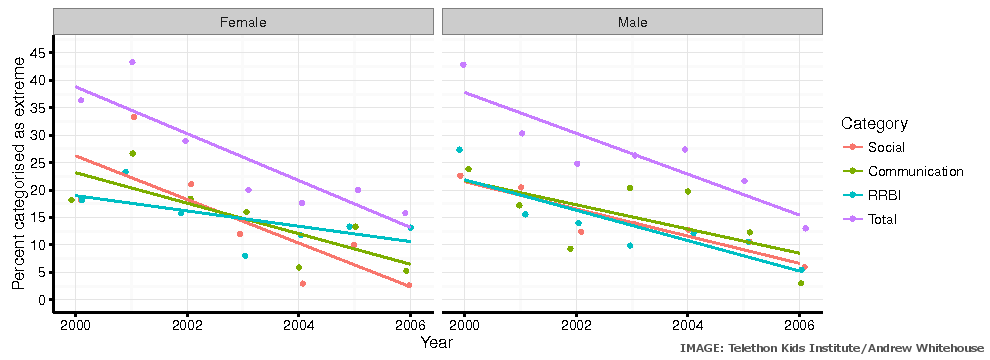Autism Explosion Explained

Rates of autism diagnosis have increased 20 fold over the last 30 years, and no, it’s not because of vaccines.
The big question is this – has there been a real increase in the number of kids with autism, or are we simply getting better at recognising the condition?
Australian researchers could have the answer, with a new study finding that the severity of behaviour from which individuals are diagnosed with autism has dropped.
Autism is a neuro-developmental disorder, which means something happens early in a person’s life (around the time of birth or possibly just after) to make the brain develop differently.
Autism runs in families and so appears to have a genetic component, but because not enough is known about the genes or the neuroscience involved, it is diagnosed by looking at behavioural factors.
These include communication impairments, social difficulties, and restrictive or repetitive behaviours. Within each of the three categories are four symptoms, and children have to show a combination of these twelve factors to receive a diagnosis.
Rates of diagnosis have skyrocketed in recent decades, up from about 1 diagnosis of autism per 2,000 kids in the 1990s to higher than 1 in 100 today.
This massive increase prompts one question – why?
If you ask Donald Trump, One Nation leader Senator Pauline Hanson, US senator John McCain or ‘independent researcher’ Jenny McCarthy, they will tell you that vaccines (pick any one) cause autism, and so the increased use of vaccines is creating an 'autism epidemic'.
This view is not only misinformed and disproven, but mildly moronic and potentially dangerous as well.
A slightly more logical hypothesis is that doctors are simply recognising more cases of autism – but even this is something researchers have struggled to prove empirically.
Professor Andrew Whitehouse, who led a recent Telethon Kids Institute study into the source of the autism spike, says his research could be “the most solid evidence [yet] as to the reason”.
Professor Whitehouse and his team used the Western Australian Register for Autism Spectrum Disorders - one of just a few such registers around the world – which allows clinicians to complete a one-page form when they make an autism diagnosis and log it in a database.
It means that WA maintains a central record of every single child diagnosed with autism in the state, including ratings (0 to 3) of each child’s combination of the 12 specific symptoms.
“Over the last twenty years we’ve captured data on 5,500 children who’ve been diagnosed with autism... what we’re reporting on in this study is between the years of 2000 and 2006, or about 1,200 kids,” Prof Whitehouse said.
Those years saw the most significant increase in the prevalence of autism.
The graph below comes from the new study, and shows a year-on-year decline in the percentage of 'extreme' autism diagnoses.

The experts say the so-called ‘autism epidemic’ is really just a shift towards diagnosing more children with less severe behaviours.
“What this represents is actually a shift in what our understanding of autism is,” Prof Whitehouse said.
“Back in the 1990s we only saw autism as quite a severe condition – children had to have intellectual disabilities and significant difficulties learning to talk.
“What has happened over the ensuing period is that we’ve recognised that autism doesn’t necessarily have to be just that severe condition.
“Children can have autism but be more mildly affected.”
Over the study period, the rate at which kids were diagnosed with extreme cases and more severe difficulties did not increase. xxx
The researchers are keen to reject the idea that the bar for autism diagnosis is now too low.
“It’s a mistake to think that all of these children that have been diagnosed with milder symptoms do not have autism. That is not the case at all,” he said.
While some may be concerned at the idea of ‘labelling’ increasing amounts of children, and fear the stigma or other social consequences that an autism diagnosis may carry, Professor Whitehouse says ultimately, it is a good thing.
“What a diagnosis does... is provide an understanding about what the underlying difficulties of a particular individual are, and what potential treatment mechanisms may be the most effective,” he said.
“A diagnosis can really inform both understanding for the individual themselves as well as their families... and also inform treatment beyond their diagnosis.”
Including a larger range of people within the autism spectrum also helps inform the search for deeper genetic, sociological or neuroscientific factors behind the condition.
But will the knowledge that better diagnostics are behind the so-called ‘autism epidemic’ change Senator Hanson’s mind?
Professor Whitehouse is less than confident.
“The anti-vax movement has shown absolutely no signs of listening to any evidence... [but] my concern is not the anti-vax movement, my concern is the truth,” he said.
“The evidence that was presented in this rigorous scientific paper is that the increase in the number of kids being diagnosed with autism is due to a diagnosis of these milder symptom kids.”
This email address is being protected from spambots. You need JavaScript enabled to view it. - CareerSpot Senior Editor








 Create PDF
Create PDF Print
Print Email to friend
Email to friend